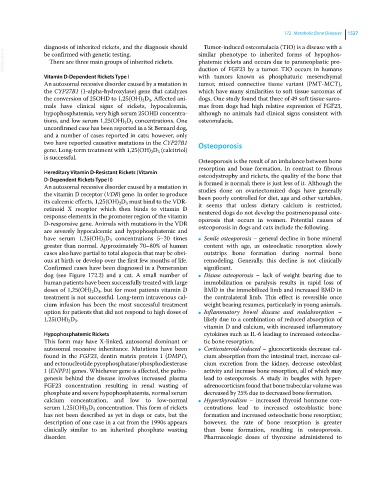Page 1589 - Clinical Small Animal Internal Medicine
P. 1589
172 Metabolic Bone Diseases 1527
diagnosis of inherited rickets, and the diagnosis should Tumor‐induced osteomalacia (TIO) is a disease with a
VetBooks.ir be confirmed with genetic testing. similar phenotype to inherited forms of hypophos
There are three main groups of inherited rickets.
phatemic rickets and occurs due to paraneoplastic pro
with tumors known as phosphaturic mesenchymal
Vitamin D‐Dependent Rickets Type I duction of FGF23 by a tumor. TIO occurs in humans
An autosomal recessive disorder caused by a mutation in tumor, mixed connective tissue variant (PMT‐MCT),
the CYP27B1 (1‐alpha‐hydroxylase) gene that catalyzes which have many similarities to soft tissue sarcomas of
the conversion of 25OHD to 1,25(OH) 2 D 3 . Affected ani dogs. One study found that three of 49 soft tissue sarco
mals have clinical signs of rickets, hypocalcemia, mas from dogs had high relative expression of FGF23,
hypophosphatemia, very high serum 25OHD concentra although no animals had clinical signs consistent with
tions, and low serum 1,25(OH) 2 D 3 concentrations. One osteomalacia.
unconfirmed case has been reported in a St Bernard dog,
and a number of cases reported in cats; however, only
two have reported causative mutations in the CYP27B1 Osteoporosis
gene. Long‐term treatment with 1,25(OH) 2 D 3 (calcitriol)
is successful.
Osteoporosis is the result of an imbalance between bone
resorption and bone formation. In contrast to fibrous
Hereditary Vitamin D‐Resistant Rickets (Vitamin osteodystrophy and rickets, the quality of the bone that
D‐Dependent Rickets Type II) is formed is normal; there is just less of it. Although the
An autosomal recessive disorder caused by a mutation in studies done on ovariectomized dogs have generally
the vitamin D receptor (VDR) gene. In order to produce been poorly controlled for diet, age and other variables,
its calcemic effects, 1,25(OH) 2 D 3 must bind to the VDR‐ it seems that unless dietary calcium is restricted,
retinoid X receptor which then binds to vitamin D neutered dogs do not develop the postmenopausal oste
response elements in the promoter region of the vitamin oporosis that occurs in women. Potential causes of
D‐responsive gene. Animals with mutations in the VDR osteoporosis in dogs and cats include the following.
are severely hypocalcemic and hypophosphatemic and
have serum 1,25(OH) 2 D 3 concentrations 5–20 times ● Senile osteoporosis – general decline in bone mineral
greater than normal. Approximately 70–80% of human content with age, as osteoclastic resorption slowly
cases also have partial to total alopecia that may be obvi outstrips bone formation during normal bone
ous at birth or develop over the first few months of life. remodeling. Generally, this decline is not clinically
Confirmed cases have been diagnosed in a Pomeranian significant.
dog (see Figure 172.2) and a cat. A small number of ● Disuse osteoporosis – lack of weight bearing due to
human patients have been successfully treated with large immobilization or paralysis results in rapid loss of
doses of 1,25(OH) 2 D 3 , but for most patients vitamin D BMD in the immobilized limb and increased BMD in
treatment is not successful. Long‐term intravenous cal the contralateral limb. This effect is reversible once
cium infusion has been the most successful treatment weight bearing resumes, particularly in young animals.
option for patients that did not respond to high doses of ● Inflammatory bowel disease and malabsorption –
1,25(OH) 2 D 3 . likely due to a combination of reduced absorption of
vitamin D and calcium, with increased inflammatory
Hypophosphatemic Rickets cytokines such as IL‐6 leading to increased osteoclas
This form may have X‐linked, autosomal dominant or tic bone resorption.
autosomal recessive inheritance. Mutations have been ● Corticosteroid‐induced – glucocorticoids decrease cal
found in the FGF23, dentin matrix protein 1 (DMP1), cium absorption from the intestinal tract, increase cal
and ectonucleotide pyrophosphatase/phosphodiesterase cium excretion from the kidney, decrease osteoblast
1 (ENPP1) genes. Whichever gene is affected, the patho activity and increase bone resorption, all of which may
genesis behind the disease involves increased plasma lead to osteoporosis. A study in beagles with hyper
FGF23 concentration resulting in renal wasting of adrenocorticism found that bone trabecular volume was
phosphate and severe hypophosphatemia, normal serum decreased by 25% due to decreased bone formation.
calcium concentration, and low to low‐normal ● Hyperthyroidism – increased thyroid hormone con
serum 1,25(OH) 2 D 3 concentration. This form of rickets centrations lead to increased osteoblastic bone
has not been described as yet in dogs or cats, but the formation and increased osteoclastic bone resorption;
description of one case in a cat from the 1990s appears however, the rate of bone resorption is greater
clinically similar to an inherited phosphate wasting than bone formation, resulting in osteoporosis.
disorder. Pharmacologic doses of thyroxine administered to

